
Senecio is a genus of flowering plants in the daisy family (Asteraceae) that includes ragworts and groundsels.

Senecio vulgaris, often known by the common names groundsel and old-man-in-the-spring, is a flowering plant in the family Asteraceae. It is an annual herb, native to the Palaearctic and widely naturalised as a ruderal species in suitable disturbed habitats worldwide.

Packera is a genus of about 75 species of plants in the daisy family, Asteraceae. Most species are commonly called ragworts or grounsels. Its members were previously included in the genus Senecio, but were moved to a different genus based on chromosome numbers, a variety of morphological characters, and molecular phylogenetic evidence.

Jacobaea maritima, commonly known as silver ragwort, is a perennial plant species in the genus Jacobaea in the family Asteraceae, native to the Mediterranean region. It was formerly placed in the genus Senecio, and is still widely referred to as Senecio cineraria; see the list of synonyms (right) for other names.

Senecio ampullaceus, also known as Texas ragwort, Texas squaw-weed, Texas groundsel, and Texas butterweed, is a species of Senecio in the family Asteraceae, receiving its Latin name ampullaceus from its flask shaped flower-head. It is recommended for landscape use in its native Texas.

Senecio squalidus, known as Oxford ragwort, is a flowering plant in the daisy family Asteraceae. It is a yellow-flowered herbaceous plant, native to mountainous, rocky or volcanic areas, that has managed to find other homes on man-made and natural piles of rocks, war-ruined neighborhoods and even on stone walls. These habitats resemble its well drained natural rocky homeland. The plants have spread via the wind, rail and the activities of botanists. The travels of this short-lived perennial, biennial, or winter annual make it a good subject for studies of the evolution and ecology of flowering plants.

Senecio eboracensis, the York groundsel or York radiate groundsel, is a flowering plant in the daisy family Asteraceae. It is a hybrid between a native and a non-native introduced species, which naturalised in England but the population failed to sustain itself. It was brought back by captive cultivation. It is a self-pollinating hybrid species of ragwort and one of only six new plant species to be discovered in either the United Kingdom or North America in the last 100 years.

Senecio flaccidus, formerly recorded as Senecio douglasii, member of the daisy family and genus Senecio also known as threadleaf ragwort, is a native of the southwestern Great Plains of North America.

Tephroseris palustris, also known by its common names swamp ragwort, northern swamp groundsel, marsh fleabane, marsh fleawort, clustered marsh ragwort and mastodon flower, a herbaceous species of the family Asteraceae. It can be seen most easily when its bright yellow umbel flowers appear from May to early July standing 3 to 4 feet along marshes, stream banks and slough areas where it likes to grow.

Senecio angulatus, also known as creeping groundsel and Cape ivy, is a succulent flowering plant in the family Asteraceae that is native to South Africa. Cape ivy is a scrambling herb that can become an aggressive weed once established, making it an invasive species. It has been naturalised in the Mediterranean Basin, where it is grown as an ornamental plant for its satiny foliage and sweet-scented flowers.
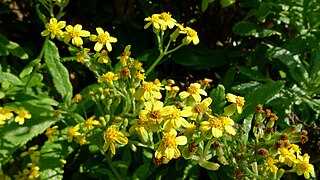
Senecio madagascariensis, also known as Madagascar ragwort, is a species of the genus Senecio and family Asteraceae that is native to Southern Africa. Other common names include Madagascar groundsel and fireweed. It has been included on the noxious weeds list for Hawaii and the reject list for Australia. S.madagascariensis is the diploid cytotype of S.inaequidens.

Barkleyanthus is a monotypic genus of flowering plants in the aster family, Asteraceae, containing the single species Barkleyanthus salicifolius, a plant formerly classified in the genus Senecio. It is native to North and Central America, where its distribution extends from the southwestern United States to El Salvador. Its common names include willow ragwort, willow groundsel, Barkley's-ragwort, and jarilla.

Senecio aphanactis, known by the common names chaparral ragwort, rayless ragwort, and California groundsel, is a species of flowering plant in the aster family.
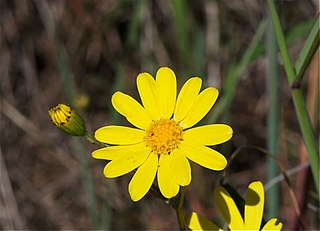
Senecio californicus is a species of flowering plant in the aster family known by the common name California ragwort.

Senecio hydrophiloides is a species of flowering plant in the aster family known by the common names tall groundsel and sweet marsh ragwort. It is native to western North America from British Columbia and Alberta to northern California to Utah, where it grows in wet meadows and similar habitat. It is a biennial or perennial herb producing a single erect stem or a cluster of a few stems which may exceed one meter in maximum height. The plants are green to red in color and usually without hairs, but new growth can be woolly. The leaves are lance-shaped to oval with toothed edges, the blades up to 25 centimeters long and borne on long winged petioles. The leaves are firm and sometimes a bit fleshy. The inflorescence is a loose or dense cluster of up to 30 or more flower heads lined with black-tipped phyllaries. They contain many yellowish disc florets at the center and often have some yellow ray florets, though these are sometimes absent. Senecio Hydrophiloides can cause Dermatitis.
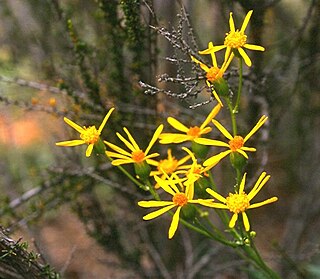
Packera layneae, known by the common name Layne's ragwort and Layne's butterweed, is a rare species of flowering plant in the aster family.
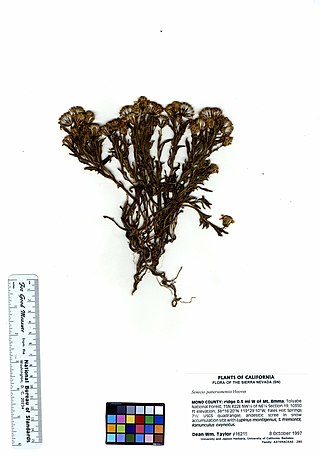
Senecio pattersonensis is an uncommon species of flowering plant in the aster family known by the common names Mono ragwort. and Mount Patterson senecio.
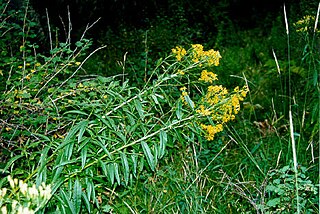
Senecio serra is a species of flowering plant in the aster family known by the common names tall ragwort and sawtooth groundsel. It is native to the western United States, where it can be found in several types of habitat, including sagebrush and woodlands. It is a perennial herb producing a single erect stem or a cluster of stems from a branched, woody caudex. The plant can exceed two meters in height. It is hairless in texture, with young plants sometimes appearing fuzzy, and green to red-tinged in color. The leaves have lance-shaped blades up to 20 centimeters long borne on short petioles, the leaves occurring evenly all along the stems. The inflorescence is a spreading array of many flower heads, each lined with green- or black-tipped phyllaries. The heads contain yellow disc florets and 5 to 8 yellow ray florets each under a centimeter long.

Senecio sylvaticus is a species of flowering plant in the aster family. It is variously known as the woodland ragwort, heath groundsel, or mountain common groundsel. It is native to Eurasia, and it can be found in other places, including western and eastern sections of North America, as an introduced species and an occasional roadside weed. It grows best in cool, wet areas. It is an annual herb producing a single erect stem up to 80 centimeters tall from a taproot. It is coated in short, curly hairs. The toothed, deeply lobed leaves are up to 12 centimeters long and borne on petioles. They are evenly distributed along the stem. The inflorescence is a wide, spreading array of many flower heads, each lined with green- or black-tipped phyllaries. The heads contain yellow disc florets and most have very tiny yellow ray florets as well.





















